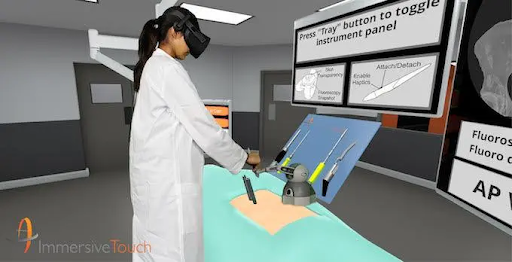Virtual reality: we’ve all heard of what it is and what we can do with it. However, it’s no longer only used for games and chatting online. It’s now being heavily introduced into medicine, preparing nurses, physicians, and surgeons for real-life practice and procedures. VR delivers cost-effective, repeatable, and standardized clinical training whenever needed. It can create situations that replicate real life, allowing the user to do what they would in the real world and then provide feedback and a debrief on the performance. So how does it work?
Opposed to 360-degree videos or simply screen-based learning, VR involves a completely immersive, dynamic, and adaptive interactive world. Medical users can take a history, perform an examination, diagnose, and treat the patient. Additional parameters can be added, such as patients becoming confused and agitated, as well as making the surrounding environment replicate the bustle of a hospital with emergency scenarios and lifelike characters in real time. These scenarios bring in the focus on decision-making, critical thinking, and clinical reasoning. Once these scenarios are completed, the user can receive a virtual debriefing and view automatically generated feedback on their performance. This feedback can be provided on technical, as well as non-technical skills carried out within the simulation. This allows users to analyze their performance in more detail and also provides the opportunity for blended learning.
VR makes accessing clinical experiences extremely simple. These systems typically consist of a headset and laptop combination, while the newest models have the console built into the headset, allowing everything to be done from the headset itself. Users can enter the VR system and take part in any simulation whenever they like. The flexibility of this access allows the integration of simulation-based learning into everyday practice. Vitally, VR scenarios are repeatable. This allows users to safely make mistakes and learn through continuous practice to improve their performance. VR also allows simulation to be delivered at a significantly reduced cost with fewer resources. Software costs vary depending on the provider and quality of the product but are usually under a tenth of the cost of physical products, such as cadavers used to practice anatomy and surgical approaches. As well as financial savings, VR tech saves space and faculty time. Most of the time, faculty do not need extra training to use VR equipment as most are commercially available (such as the Meta Quest systems). Any virtual scenario takes place in a very small space, such as a single room, with under 5 minutes of setup. The cost reduction allows VR to be distributed globally. It has a strong potential to equal the ability of quality medical training, making VR an exciting prospect.
Despite its advantages, VR has its flaws. Implementation requires technical support. There’s also the argument that though the scenarios are identical, performing them in real life and in VR is entirely different. This is partially true, as physical limitations do exist within virtual reality. Some see it as a game, rather than an educational tool. Another issue is the subconscious thought of the scenario not being real. The “patient” being operated on is not a real person, therefore, when being presented with a real one, the user can become disoriented as the mistakes made in the relaxed simulation cannot be made.
So, does it work? Numerous lines of evidence demonstrate how VR and its immersion deliver effective learning. VR is not only used in medicine. Multiple fields utilize the technology, such as aviation, oil, shipping, and the military. Studies in healthcare support the value of VR. Medical students demonstrate significantly higher knowledge gain when using an immersive environment as opposed to a screen or a 360-degree video. Immersive VR has now been widely used in surgical training, where it has been demonstrated to reduce harm, speed up procedures, and enhance overall results. With great success, it has now been incorporated into many surgical programs.

